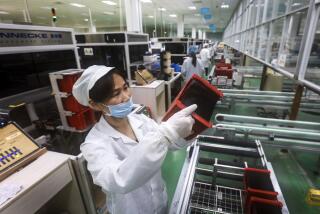Japan Adopts $115-Billion Plan to Spur Economy : Asia: Analysts say it will speed growth but is unlikely to reduce big trade surplus that causes friction with U.S.
In an effort to jump-start Japan’s sluggish economy, the Japanese government Tuesday adopted a record $115-billion package to provide money for everything from burying the rat’s nest of overhead electric cables in Tokyo to making more low-interest loans available to home buyers.
The package is more than seven times the size of President Clinton’s economic stimulus package now blocked in the Senate. While it will help revive a Japanese economy that is just now beginning to show signs of life, analysts say, it is unlikely to help correct the yawning trade surplus that is putting Japan on a collision course with America.
In an announcement that served as a reminder of Japan’s worsening trade problem, the Bank of Japan said Tuesday that the nation’s trade surplus in March rose 26% from the year before to set a record surplus for the month of $13.8 billion. The March surplus with the United States widened to $4.44 billion, up from $3.11 billion in March, 1992.
Early reaction from U.S. officials to the stimulus plan has been cool. Secretary of State Warren Christopher, in Tokyo for ministerial meetings of the Group of Seven top industrial countries, said the new package is a “good first step” toward reviving Japan’s economy to boost imports. But in talks with Japanese Foreign Minister Kabun Muto, he urged Japan to do more to remove structural barriers, according to press reports.
Clinton Administration officials have suggested that the only way to cut Japan’s trade surplus is to set numerical targets for Japanese purchases of U.S. goods. Noboru Hatakeyama, vice minister at the Ministry for International Trade and Industry, strongly resisted such arguments.
“There is absolutely no room for us to consider the goal approach because it leads to misunderstanding and managed trade,” he said Tuesday. “It would mean forcing Japanese consumers to buy things they don’t really need.”
In a reflection of Japan’s resistance to guaranteeing a set level of imports, the stimulus package makes no references to purchases of U.S. products. When the final details are ironed out, however, it could include money for supercomputers, personal computers and aircraft. American companies would presumably be allowed to bid for the business on a competitive basis with Japanese companies.
Japan’s financial markets greeted the stimulus package much more enthusiastically. Reacting to the larger-than-expected size of the package, stock prices soared. The Nikkei Index climbed 858.15 points, or 4%, to close at 20,740, its highest close in more than a year.
Hiroshi Mitsuzuka, a leading member of Japan’s ruling Liberal Democratic Party, said the package will “make certain” that Japan will achieve its growth target of 3.3% this year. Last year, the Japanese economy grew by just over 1% compared to the original target of 3.5%. An $85-billion stimulus measure adopted in October was not enough to correct a downturn that proved more severe than expected, a Finance Ministry official said.
The latest package, which officials hope will pass Parliament by June, was unveiled early in hopes of setting a favorable environment for Prime Minister Kiichi Miyazawa’s talks with President Clinton on Friday.
Economists are pessimistic.
“At best this package will help keep Japan’s trade surplus to last year’s level,” said Makoto Sakurai, chief economist at Mitsui Kaijo Research Institute.
A Bank of Japan official said that neither the strong yen nor the increased domestic growth is likely to significantly reduce Japan’s trade surplus over the next two years.
The package includes about $70 billion in what economists call “real” new public spending. In addition to the typical infrastructure spending on such things as roads and bridges, Japan budgeted nearly $1 billion for “social infrastructure.”
The Japanese government will also take $42 billion from its Fiscal Investment and Loan Program, mostly money from post office savings accounts, to boost low-interest loans available for housing purchases and investments in new factory equipment.
Some economists argue that this money should not be counted as a net stimulus from the government because it is cash that the public would have deposited in private banks if the postal savings accounts did not exist.
The package does not address the growing bad-debt problem of Japanese banks. It also does little to correct what economists say is the primary cause of Japan’s trade surplus: a structural bias in favor of investment over consumption.
Many of the proposed measures, for example, are designed to encourage additional investments in factory equipment. The government will offer a 7% tax credit for investments made by companies in new factory equipment, for example. And an additional $11 billion in low-interest loans will be made available to small businesses.
While labor and energy savings are given as the primary reasons for such investments, they almost always lead to added production capacity. Export drives are the result of efforts to put that capacity to use.
Ironically, such spurs to investment, while far more important to the U.S. economy than to the Japanese economy, are expected to be struck from Clinton’s $16-billion stimulus package that Senate Republicans have filibustered.
Japanese consumers will find little to applaud in the new stimulus package. The deduction for interest for housing loans will be increased by only $430 to a maximum deduction for mortgage interest of $2,575. One proposal had been to increase the deduction by $2,000. A proposal for a broad income tax cut also was shelved.
Highlights of Stimulus Package (Southland Edition, A6)
Japan’s $115-billion economic stimulus package announced Tuesday includes:
$93 billion for public investment, including public works, housing loans and educational, research, medical and social welfare projects.
$16 billion in assistance to small- and medium-size enterprises.
$4.6 billion for promotion of private-sector capital investment.
$1.6 billion in tax cuts and job subsidies.
Source: Times wire reports
More to Read
Sign up for Essential California
The most important California stories and recommendations in your inbox every morning.
You may occasionally receive promotional content from the Los Angeles Times.










